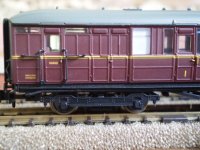When the London & North Eastern Railway was created in the 'grouping' of 1923, the new
company's directors needed a capable and experienced Chief Mechanical Engineer to oversee
the creation of a new generation of modern locomotives and rolling stock. The man they turned to
was Herbert Gresley, CME of one of the LNER's constituents, the Great Northern Railway, and
what a wise choice it was. Gresley and his draftsmen drew up a series of big powerful express
passenger locomotives to bring high-speed rail travel to the East Coast Main Line, culminating
in the streamlined A4 pacifics which rewrote the record books. In 1936 Gresley was knighted
for his achievements, confusingly adopting his middle name to style himself 'Sir Nigel', and in
1938 his A4 loco 4468 'Mallard' made its famous 126mph sprint down Stoke Bank to set a
world steam speed record which still stands to this day.
These locomotives needed suitable passenger stock for the glamorous high-speed trains, of
course, and the ageing vehicles which the LNER inherited didn't really fit the modern image.
A new fleet was needed for this new dawn, and Gresley and his boys rose to the challenge
admirably. Their designs combined the best of old and new to create the ultimate in 1930s
comfort and style, resplendent in the varnished teak so characteristic of the East Coast line
in railways' Golden Age. It couldn't last, of course, and the war brought an end to railway
glamour and style and speed records. The post-war era brought an end to the LNER,
absorbed into British Railways, and the teak vanished under BR's crimson & cream.
By the late 1950s BR had built its own fleet of new modern carriages for its top
trains, and Gresley's coaches were elbowed off the main line onto secondary routes and
branchlines. You couldn't keep a good design down though, and the Gresleys gave yeoman
service in their new role. Some even survived into the 1970s, wearing the corporate blue &
grey, and were the last wooden-bodied coaches on British Railways. Our models show the
coaches in the maroon livery of the late 1950s and early 1960s. The coach roof unclips
to reveal a detailed interior, even including the brake control wheel in the guard's
compartment. The seats are correctly represented as blue in First Class and red in
Second.
It's been a long time since the branchlines of the Eastern Region saw a steam-hauled passenger
service. Recreate this bygone scene on your layout with our Gresley Branchline Set.
|




